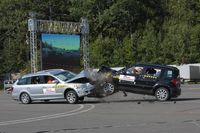Czech Crash Testing Confirms The High Quality Standard Of Safety Of Skoda Cars
BOTANY, AUSTRALIA – Sept 13, 2010: A unique crash test was performed at the Skoda Auto testing polygon in ┌helnice on 7th September 2010 in front of a specialist public. For the first time in the Czech Republic a frontal offset crash of two Škoda cars was presented to a Traffic Safety Research team where a Škoda Yeti, travelling at a speed of 90km/h, hit a standing Škoda Superb Wagon head on. Both cars were carrying four crash test dummies which had their seat belts fastened and secured with safety elements. The results of the crash test was clear: the occupants of both cars, in the case of a real crash at a speed of 90km/h, would come out of the crash without any injuries subject to all safety elements being used correctly.
The crash test was originally inspired by a real traffic accident that the Škoda Auto Traffic Safety Research team had analysed. Here photographs showed that the entire energy of the impact at a speed of 90 km/h was absorbed by the front part of the car without having any impact on the space of the passengers. Further, upon close examination of the shots from the high-speed cameras, the rapid reaction of the car’s electronic systems that activates the safety elements showcased the safety standards of the cars even further. At this time the safety belts, knee and front airbags already had been activated before the test dummies had any chance to move as a result of the impact. Only 45 thousandths of a second after the bumpers first touched, all the airbags had already absorbed the human body’s energy.
Although the crash test in ┌helnice was of a different type and in a higher speed, the assessment methodology of the independent Euro-NCAP association used was the same in comparing the stress on the occupants during the impact. The results were further proved by a more detailed analysis of selected measurements, such as in the case of the amount of stress experienced on the passengers’ heads or compression of the passengers’ chests. The European ECE R94 regulation, according to which all cars for use on European highways undergo homologation, prescribes a maximum value of 80 G for stress on a car passenger’s head which is the maximum value of acceleration that the human brain can handle for a short period without any serious damage. The value measured on the head of the driver’s dummy in the Škoda Yeti only reached 44% of the value permitted by the regulation, which less than half of the level European ECE R94 regulation prescribes.
In the case of compression of an adult passenger’s chest, similar conclusions were applied where the measured value was around 35.7% percent of the permitted limit. The values permitted for stress on the thigh bones were only at 20% of the permitted maximum.
In local terms the Czech crash test has been conducted with a far higher speed used (90km/h) than in Australian testing where ANCAP crash test speed for frontal offset crash test is conducted at 64km/h. Further according to real-world (US) data, more than half of all fatalities to seat-belt-wearing drivers in frontal crashes occur at impact speeds under 55km/h. The testing evidently demonstrates the high standard of safety of Škoda cars, thereby confirming Skoda’s ongoing commitment to occupant safety for its customers.



